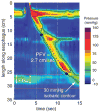Esophageal motility disorders in terms of pressure topography: the Chicago Classification
- PMID: 18364587
- PMCID: PMC2895002
- DOI: 10.1097/MCG.0b013e31815ea291
Esophageal motility disorders in terms of pressure topography: the Chicago Classification
Abstract
Two recent advances have revolutionized the performance of clinical esophageal manometry; the introduction of practical high resolution manometry (HRM) systems and the development of sophisticated algorithms to display the expanded manometric dataset as pressure topography plots. We utilized a large clinical experience of 400 consecutive patients and 75 control subjects to develop a systematic approach to analyzing esophageal motility using HRM and pressure topography plots. The resultant classification scheme has been named as the Chicago Classification of esophageal motility. Two strengths of pressure topography plots compared with conventional manometric recordings were the ability to (1) delineate the spatial limits, vigor, and integrity of individual contractile segments along the esophagus and (2) to distinguish between loci of compartmentalized intraesophageal pressurization and rapidly propagated contractions. Making these distinctions objectified the identification of distal esophageal spasm, vigorous achalasia, functional obstruction, and nutcracker esophagus subtypes. Applying these distinctions made the diagnosis of spastic disorders quite rare: spasm in 1.5% of patients, vigorous achalasia in 1.5%, and a newly defined entity, spastic nutcracker, in 1.5%. Ultimately, further clinical experience will be the judge, but it is our expectation that pressure topography analysis of HRM data, along with its well-defined functional implications, will prove valuable in the clinical management of esophageal motility disorders.
Conflict of interest statement
The authors declare no conflict of interest.
Figures











References
-
- Pandolfino JE, Zhang Q, Ghosh SK, et al. tLESRs and reflux: mechanistic analysis using concurrent fluoroscopy and high-resolution manometry. Gastroenterology. 2006;131:1725–1733. - PubMed
-
- Clouse RE, Staiano A. Topography of the esophageal peristaltic pressure wave. Am J Physiol. 1991;261:G677–G684. - PubMed
-
- Clouse RE, Staiano A, Alrakawi A, et al. Application of topographical methods to clinical esophageal manometry. Am J Gastroenterol. 2000;95:2720–2730. - PubMed
-
- Pandolfino JE, Ghosh SK, Zhang Q, et al. Quantifying EGJ morphology and relaxation with high-resolution manometry: a study of 75 asymptomatic volunteers. Am J Physiol (Gastrointest Liver Physiol) 2006;290:G1033–G1040. - PubMed
-
- Ghosh SK, Pandolfino JE, Zhang Q, et al. Quantifying esophageal peristalsis with high-resolution manometry: a study of 75 asymptomatic volunteers. Am J Physiol (Gastrointest Liver Physiol) 2006;290:G988–G997. - PubMed
Publication types
MeSH terms
Grants and funding
LinkOut - more resources
Full Text Sources
Other Literature Sources

